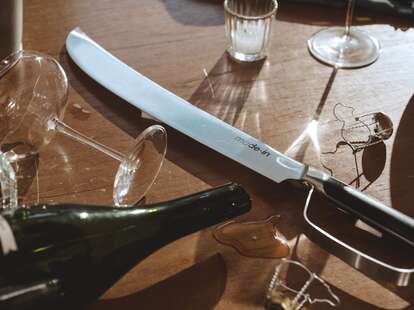
Photo courtesy of Made In
I have never sabered a bottle of champagne, but I’d be lying if I didn’t admit that it looks cool as hell. The sword, the swift motion, the burst of bubbles alongside a roomful of cheers—it’s a party trick that’s more exciting than breaking an apple in half with your bare hands and certainly “pick a card, any card.”
Sabering a champagne bottle, however, comes with its own necessary precautions. At the end of the day, you’re working with glass, a sword, and a bottle of bubbles that is under extreme pressure. We can’t all be as suave as Napoleon and his army on horseback (which, according to myths, is allegedly where the idea of sabering first came from).
Thankfully, if you do want to try sabering at home—be careful!—we have some helpful tips from the experts. Gina Netisingha, the beverage director of the Seagate Hotel, has sabered hundreds of champagne bottles throughout her career. For expertise, we’ve also tapped Jake Kalick, cofounder of Made In, who thoughtfully designed a champagne saber because it’s been his go-to party trick for years. Here’s their sage sabering advice.
Keep the bottle cold
“The purpose of this is that it makes the glass very brittle, and also reduces the CO2 inside of the bottle, so that it’s less dangerous when you are actually sabering it,” Netisingha explains. “The bottle should be sitting between 36 and 42 degrees.” To do this, either keep the champagne bottle in your fridge for three hours or put the bottle upside down in a bucket of ice until the neck is fully chilled.
Make sure the bottle is naked and find the seam
You don’t want your blade to get caught on the cage or any remaining foil, so make sure your champagne bottle is completely naked before wielding a sword against it. From there, find the seam. Every glass bottle of champagne should have a seam that runs all the way through the bottle, marking the point where the glass was initially sealed
“The little ridge piece that sticks out where the seam meets that top of the bottle—in that space the bottle integrity drops down to about 50 percent,” Netisingha says. “So the reason that you’re able to saber it is because that bottle is weakest at that point.”
Hold the bottle correctly
“The first most important is keeping an eye on your finger placement, a.k.a. keep fingertips out of the path of the blade,” Kalick says. Although that seems obvious, it feels more natural and comfortable to hold a champagne bottle by its neck. Instead, using your non-dominant hand, hold the bottle at the bottom, placing your thumb in the divet known as the punt. The bottle should feel secure in your hand.
From there, make sure the bottle is at a 45-degree angle, seam-side up, ready to be cleaved.
Commit to the motion
At this point, you have to channel your inner Tiger Woods or Serena Williams and commit to the swing, following through in one swift motion. “You’re going to be using that seam in the same way that you would a golf swing—so a very smooth transition all the way across the seam, hitting the very crux of the bottle where there’s that first ridge of the neck of the bottle,” Netisingha explains. If all goes well, the neck should fly off and you’ve successfully sabered your bottle.
However, all does not always go well. If you’ve chipped away at the neck, but unsuccessfully beheaded the bottle, you have to open it as soon as possible. “You have to open it immediately or it’s going to explode and it’s super, super dangerous—you’ll have glass shattered all over the place,” Netisingha advises. “You cannot continue to try to saber it.”
Don’t use a sharp blade
Kalick specifically designed the Made In champagne saber to be aesthetically pleasing, complete with an ebony wood handle and chic knife guard for hand safety. The blade is also purposely dull—meant to be a decorative piece that can hang out in a bookshelf but also safely saber a champagne bottle. If you’re not yet comfortable sabering, Kalick suggests “using the back of the blade until you feel very comfortable flipping the knife to the front.” The back of the blade, which is much duller, will still be able to pop the top of the champagne neck bottle off, but is a little bit safer for your fingers than the sharper blade side.
Take precautions
Again, this is a dangerous activity. Even Netisingha, who has estimatedly sabered over a hundred champagne bottles—including at President Barack Obama’s inauguration—remains terrified of the act. “I’m going on 20 years now, and even I still have the days that I just don’t hit it right. It’s not a sure fire with every bottle,” she says.
So with all this in mind, you can always just open champagne the regular way. People will still be happy to see bubbles, we promise.